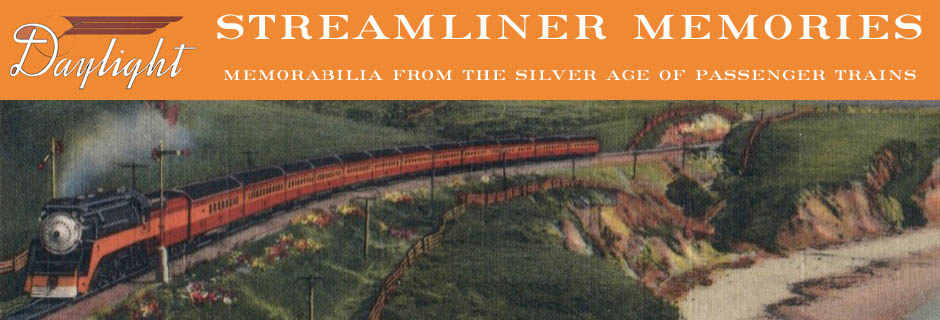Bernard Hill was born in Toronto in 1911. After studying art in Toronto and London, England, Hill worked for a variety of printing and advertising companies. In 1940, he moved to New York where he soon went to work for the Kudner Agency. Founded by Art Kudner in 1935, Kudner’s clients included General Motors and Goodyear Tires, growing to be the eighth-largest advertising company in the nation.
 The second Railway Age cover signed by Bern Hill shows a Twin Zephyr meandering south along the Mississippi River. Click image to download a 3.4-MB PDF of this magazine cover. Click here for a 33.2-MB higher-resolution version of this PDF. Unless otherwise noted, all images on this page are from Greg Palumbo’s collection of Kudner Agency ad proofs.
The second Railway Age cover signed by Bern Hill shows a Twin Zephyr meandering south along the Mississippi River. Click image to download a 3.4-MB PDF of this magazine cover. Click here for a 33.2-MB higher-resolution version of this PDF. Unless otherwise noted, all images on this page are from Greg Palumbo’s collection of Kudner Agency ad proofs.
Art Kudner died in 1944, after which the company was headed by James Ellis, who had been with the company since its founding. Ellis was a good friend of Harlow Curtice, who headed General Motors’ Buick Division in the 1930s, became its executive vice-president in 1948 and its president in 1953. Through that friendship, Kudner gained the business of several General Motors divisions including Buick and EMD.
For the first part of 1950, Hill’s Railway Age covers came in twos: two back-to-back in February, two in April, two in June, two in August. The first one in April showed Burlington’s Twin Zephyr, with vista-domes barely visible, from a point so high that the earth can be seen curving away from the viewer in the upper part of the painting. Hill’s signature is at the very bottom left of the magazine cover.
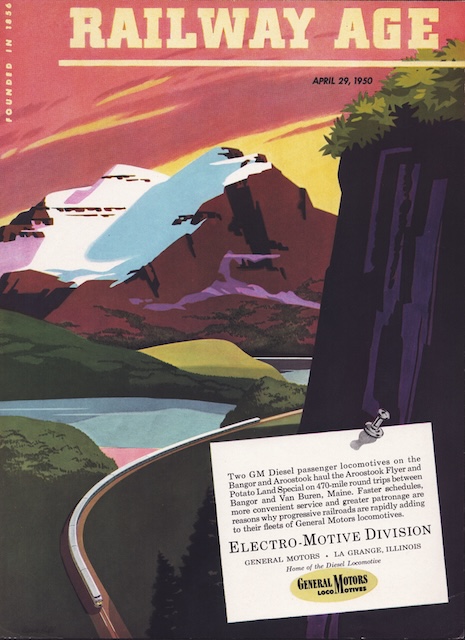 Railway Age‘s April 29 cover shows a Bangor and Aroostook passenger train navigating through canyons and mountains. Click image to download a 2.9-MB PDF of this magazine cover. Click here for a 28.4-MB higher-resolution version of this PDF.
Railway Age‘s April 29 cover shows a Bangor and Aroostook passenger train navigating through canyons and mountains. Click image to download a 2.9-MB PDF of this magazine cover. Click here for a 28.4-MB higher-resolution version of this PDF.
Three weeks later, Hill showed the Bangor and Aroostook, a Maine railroad, but featuring mountains never before seen in Maine. Hill’s signature is barely visible in the lower left corner of the painting.
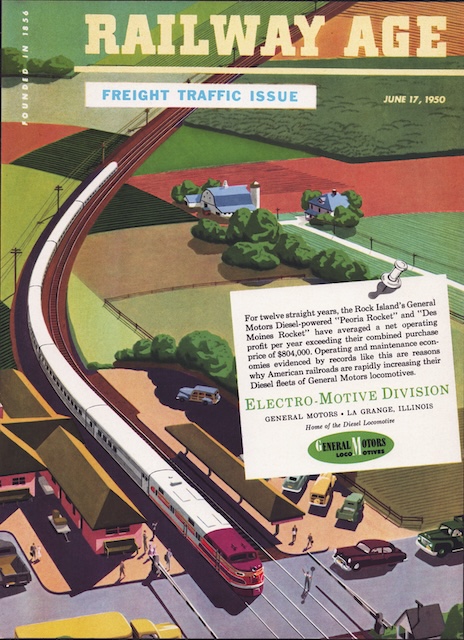 The Rock Island Rockets were some of the first streamliners to be pulled by General Motors’ cab-style locomotives. Click image to download a 2.6-MB PDF of this magazine cover. Click here for a 25.8-MB higher-resolution version of this PDF.
The Rock Island Rockets were some of the first streamliners to be pulled by General Motors’ cab-style locomotives. Click image to download a 2.6-MB PDF of this magazine cover. Click here for a 25.8-MB higher-resolution version of this PDF.
Unlike the previous two covers, this one of a Rock Island Rocket doesn’t have a visible signature. But who other than Bern Hill would draw passenger cars that curved with the curvature of the rails?
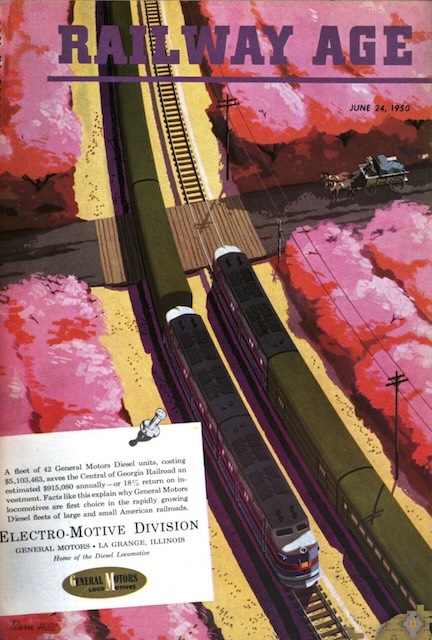 Two Central of Georgia passenger trains pass through peach orchards in full bloom. This image is from Google books. Click image to download a 1.7-MB PDF of this magazine cover.
Two Central of Georgia passenger trains pass through peach orchards in full bloom. This image is from Google books. Click image to download a 1.7-MB PDF of this magazine cover.
Compared to the previous cover images, Hill’s painting of Central of Georgia trains presents an almost close-up view of the locomotives. Central of Georgia owned F3s purchased in 1947 and 1948 and E8s purchased in August of 1948. Although the E8s hadn’t yet been delivered, this ad may be General Motors’ thanks for buying those locomotives. Hill’s signature is visible in the lower-left corner of the painting.
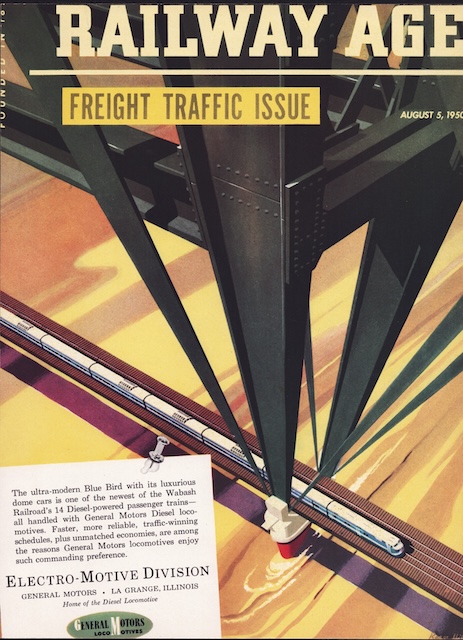 Even Bern Hill couldn’t pretend that the Wabash Railroad passed through mountains, so this scene looks down on the Blue Bird passenger train from a high bridge tower. Click image to download a 2.4-MB PDF of this magazine cover. Click here for a 25.4-MB higher-resolution version of this PDF.
Even Bern Hill couldn’t pretend that the Wabash Railroad passed through mountains, so this scene looks down on the Blue Bird passenger train from a high bridge tower. Click image to download a 2.4-MB PDF of this magazine cover. Click here for a 25.4-MB higher-resolution version of this PDF.
Wabash’s Budd-built Blue Bird consisted of a baggage-cafe car, three dome coaches, a diner, and a dome-parlor-observation car. Hill’s painting left off the baggage-cafe car. Hill’s signature is visible, though partly cut off, in the lower right corner.
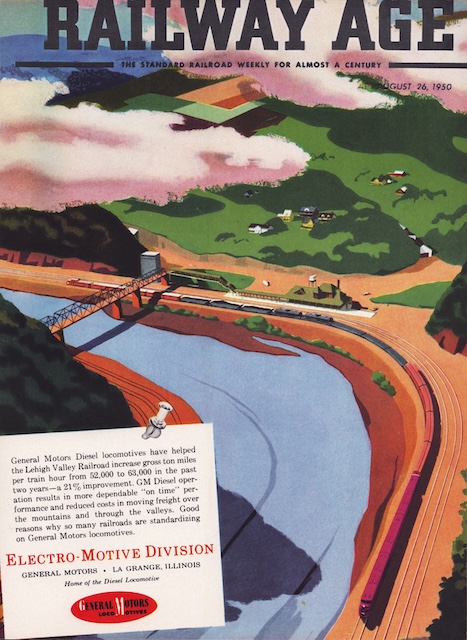 This painting of a Lehigh Valley train is the first Bern Hill cover since the Southern Railway that featured a freight train, not a passenger train. Click image to download a 3.0-MB PDF of this magazine cover. Click here for a 25.5-MB higher-resolution version of this PDF.
This painting of a Lehigh Valley train is the first Bern Hill cover since the Southern Railway that featured a freight train, not a passenger train. Click image to download a 3.0-MB PDF of this magazine cover. Click here for a 25.5-MB higher-resolution version of this PDF.
Lehigh Valley Railroad purchased FT locomotives from General Motors in 1945 and F7 locomotives in 1948, but it did not own any of the longer E locomotives. Yet the A-B-A locomotives in this painting appear to be too long for F units. Note that in Hill’s universe, even freight cars curve to match the curvature of the rails. Hill’s signature is covered up by the note in the lower left of the cover.
